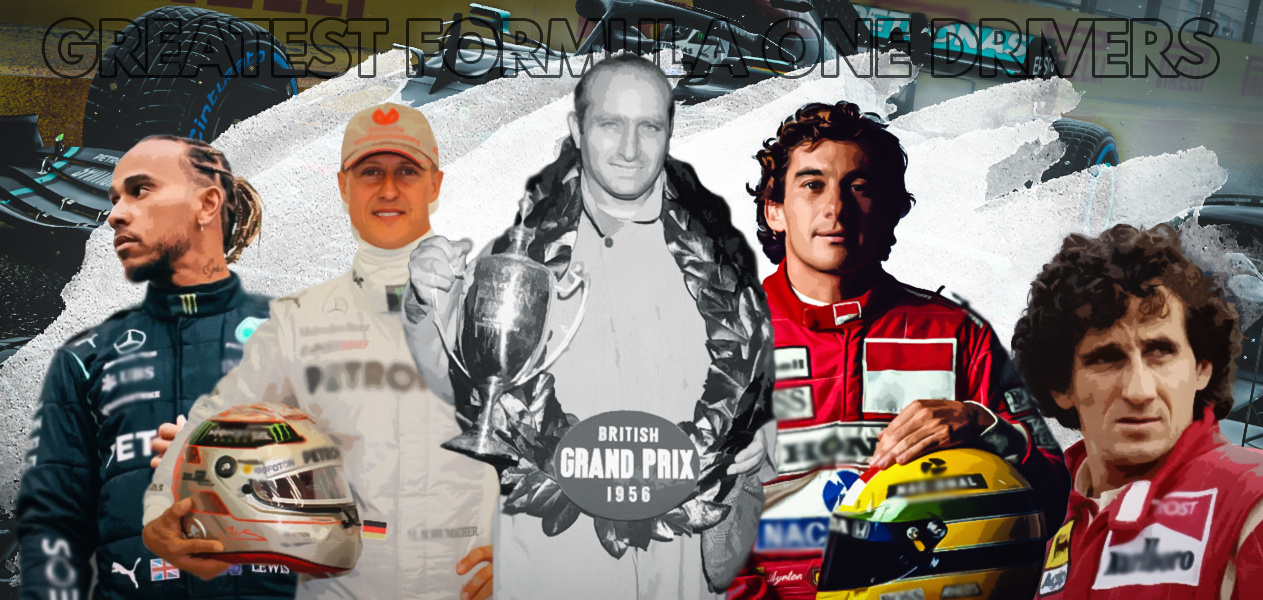TOP 10: THE GREATEST FORMULA ONE DRIVERS OF ALL TIME
Looking at a few of the greats.
Formula One is the pinnacle of motorsports and has produced some of the greatest athletes over its long history. Here, we look at ten such drivers who changed the sport forever and will go down in history as few of the greatest to have ever graced the sport.
1. Juan Manuel Fangio – 5 World Driver’s Championships (Alfa Romeo, Maserati, Mercedes, Ferrari)
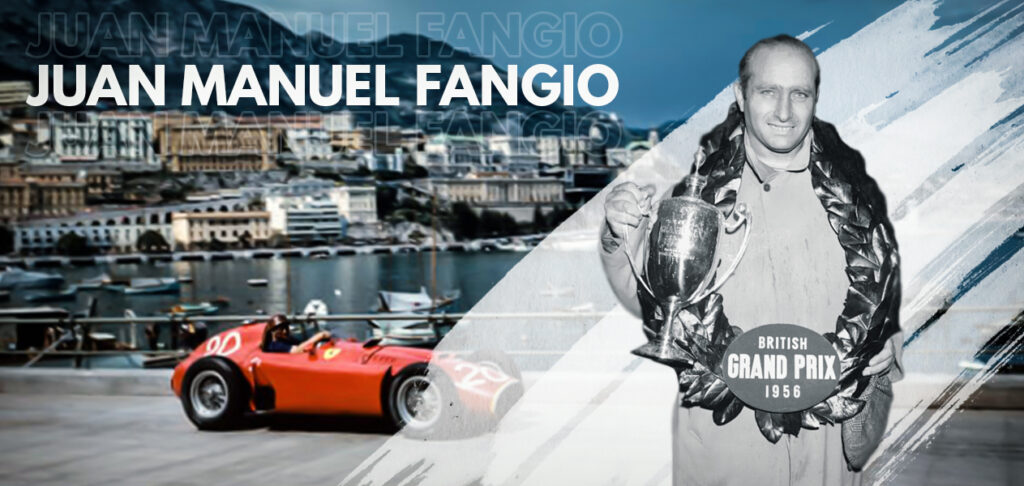 Called ‘El Maestro’, Juan Manuel Fangio was truly in a league of his own during his era. With five titles, Fangio dominated the 50s and his record of five world titles stood for almost half a century until Michael Schumacher surpassed it. Fangio claimed five championships with four different teams (Alfa Romeo, Ferrari, Mercedes-Benz and Maserati) and won almost half of the races he entered (24 out of 52). Today, Formula One is known for its safety, with drivers being safeguarded against the worst of crashes and incidents and being able to walk away without any major injuries. But that wasn’t the case in the 1950s, when drivers raced with almost no protective gear, no safety measures on the circuits and the races were much longer which required incredible physical stamina from the drivers. With no electronic aids in their cars and with tyres that wore out far too easily and early, competing in Formula One in the 1950s needed not only physical but also mental strength. Fangio once was in a dual driver race during the start of his career in Peru, and due to the conditions of the road the car went down a mountainside and his co-driver was flung from the car, later succumbing to his injuries. Although the incident shook Fangio, his mental resilience and determination kept him going.
Called ‘El Maestro’, Juan Manuel Fangio was truly in a league of his own during his era. With five titles, Fangio dominated the 50s and his record of five world titles stood for almost half a century until Michael Schumacher surpassed it. Fangio claimed five championships with four different teams (Alfa Romeo, Ferrari, Mercedes-Benz and Maserati) and won almost half of the races he entered (24 out of 52). Today, Formula One is known for its safety, with drivers being safeguarded against the worst of crashes and incidents and being able to walk away without any major injuries. But that wasn’t the case in the 1950s, when drivers raced with almost no protective gear, no safety measures on the circuits and the races were much longer which required incredible physical stamina from the drivers. With no electronic aids in their cars and with tyres that wore out far too easily and early, competing in Formula One in the 1950s needed not only physical but also mental strength. Fangio once was in a dual driver race during the start of his career in Peru, and due to the conditions of the road the car went down a mountainside and his co-driver was flung from the car, later succumbing to his injuries. Although the incident shook Fangio, his mental resilience and determination kept him going.
In today’s day and age where drivers make their Formula One debut even before the age of 20, Fangio started his Formula One career in his late thirties. He currently holds the highest percentage of wins (46.15%) and is the oldest world champion, winning his fifth and final title at the age of 46.
It’s Fangio’s stunning record with his incredible determination that saw him dominate the sports even in his 40s and what places him as one of the greatest drivers to have ever raced in the sport.
2. Ayrton Senna – 3 World Driver’s Championships (Toleman, Lotus, McLaren, Williams)
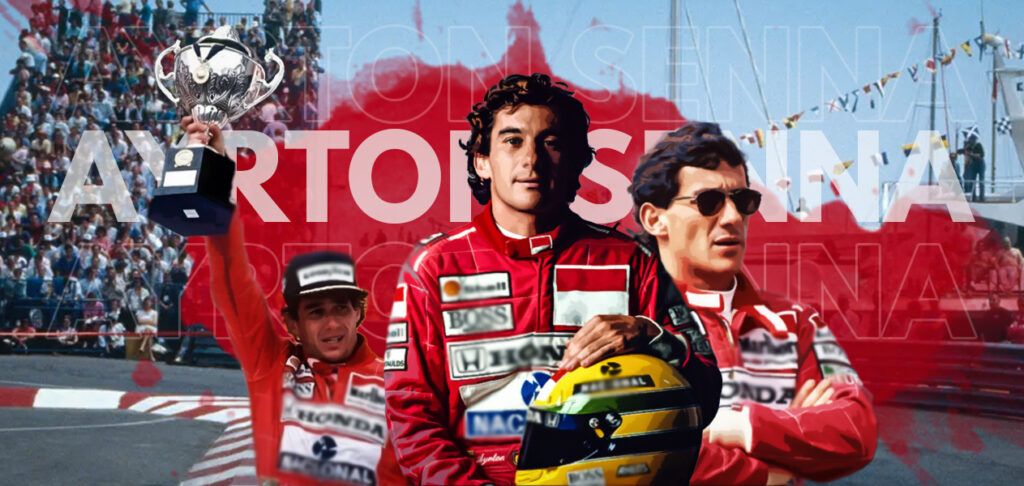 If there has been any driver who changed the way the world viewed the sport, it would have to be Ayrton Senna. Although short, Senna’s career was one of the most remarkable ones.
If there has been any driver who changed the way the world viewed the sport, it would have to be Ayrton Senna. Although short, Senna’s career was one of the most remarkable ones.
Senna made his debut in the 1984 season with Toleman where despite not having a competitive car he managed to impress everyone with his drives in the wet. The next few seasons saw a meteoric rise of the Brazilian; having joined Lotus, Senna thrived in an environment that gave him a chance to fight for podiums and wins. He began to grab headlines. Within a few years, Senna joined Alain Prost at McLaren. The two drivers fought tooth and nail, with Senna having the final laugh by winning his first World Championship in 1988. The following season probably saw one of the greatest rivalries in modern-day sport as Prost wasn’t happy with the newcomer taking the championship in his first season. The on-and-off-field battle between Prost and Senna became a true psychological warfare. The tension between the two came to its summit when Prost secured his third-world championship in Japan. With Senna starting on pole followed by his teammate, it was the Frenchman who got the better start and jumped Senna at the start. Prost maintained the lead for almost the entirety of the race until Lap 46, when Senna made a last-gasp attempt to keep his championship hopes alive and tried to overtake the Frenchman, but Prost held his line and closed the door, leading to a collision between him and Senna. Although Prost was out on the spot, Senna re-entered the race through the run-off road and eventually took the win.
After a lengthy debate with the FIA, Senna was disqualified and Prost was automatically handed his third world title.
Their rivalry resumed the season after, with Prost having shifted to Ferrari. Yet again, Suzuka would be the championship-deciding track where the race would be marred by controversy once again. Senna entered the Japanese Grand Prix as the championship leader and knew a win or DNF for both would win him the title. A collision between the two this time saw both cars retire on the spot and Senna take the driver’s title.
One of Formula One’s most charismatic drivers, one who inspired generations to come, unfortunately had his life cut short at the 1994 San Marino GP. Although his life ended then, it was the start of Senna’s majestic legacy that inspires drivers even today.
Senna might divide opinion has a man, but he definitely united all as a driver.
3. Niki Lauda – 3 World Drivers’ Championships (March, BRM, Ferrari, McLaren, Brabham)
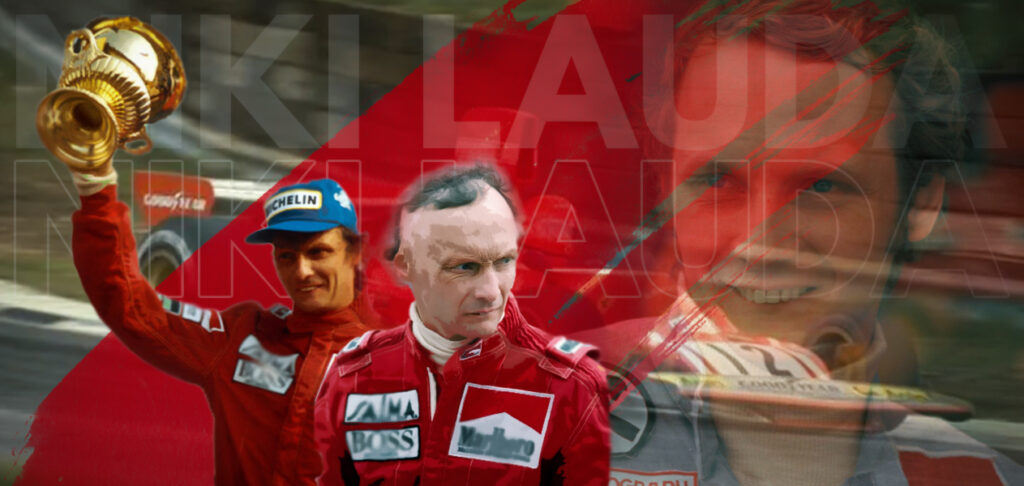 Niki Lauda had three world championship titles, but that’s not the biggest part of his legacy. Lauda’s legacy is built on his immense will power, resilience and never-say-die attitude that saw him not only fight his way through a life-ending accident but come back from it a mere 40 days later to get inside his Ferrari and get back to racing.
Niki Lauda had three world championship titles, but that’s not the biggest part of his legacy. Lauda’s legacy is built on his immense will power, resilience and never-say-die attitude that saw him not only fight his way through a life-ending accident but come back from it a mere 40 days later to get inside his Ferrari and get back to racing.
Formula One’s safety today should not undermine the fact that over the years this sport has been one of the deadliest and life-threatening ones. Lauda literally bought his way into the sport, taking a bank loan to buy himself a seat with the incredibly uncompetitive March. March’s uncompetitiveness left Lauda to take yet another loan to get him a seat with the BRM team, and even though the BRM team was in decline, Lauda’s skill and talent caught the eye of a certain Enzo Ferrari, who subsequently signed him up for the 1974 season.
Lauda took his first world driver’s title in 1975, and it was the first time people saw his ‘never give up’ attitude. Lauda was relentless, and would take the car the extra mile to make sure he got the result he wanted. A prime example of this was in the German Grand Prix in 1975; even though Lauda started on pole, a puncture saw him having to limp back to the pits with massive damage on the front wing. By the time Lauda made it out of the pits he was a lowly P5. From there, Lauda charged through the field to end up on the podium again. The ’76 season saw a strong start from the Austrian as he ran away into a healthy championship lead and by the half-way stage, Lauda had double the points of his closest rival.
Lauda came into the 1976 German Grand Prix at the Nürburgring with a comfortable championship lead, but due to the circuit’s safety arrangements – including lack of fire and safety equipments, fire marshals and safety cars – Lauda asked his fellow drivers to boycott the race. Most of the drivers were against boycotting the race, however, so it went ahead as planned. On the second lap, Lauda’s Ferrari veered off and crashed, bouncing off the barriers and back onto the racetrack. The car went up in flames, with two oncoming cars also crashing into it. Italian driver Arturo Merzario, along with Brett Lunger and Guy Edwards, fearlessly put themselves at risk to help their fellow driver. Merzario went straight into the flaming car and helped Lauda unbuckle his seatbelt and pull him out of the car, which effectively saved his life. The incident resulted in third-degree burns to Lauda’s face and head, burning out most of his right ear, eyebrows, eyelids and right side of his head. What was worse than the burns was that the gases had damaged his lungs, and Lauda even slipped into coma for a brief while. At the hospital, a priest was reported to have performed the last rites, with little hope of Lauda making it out from the hospital.
This spurred on Lauda, making him angry, and his will power and resilience saw him get back to his feet.
Six weeks after an accident that should have killed him, with credit to his his selfless fellow drivers, medical professionals and an undying spirit to never give in, Niki Lauda was back in his Ferrari car in Monza and finished a remarkable fourth, fighting through all the physical pain and agony of his burns and injuries. Having missed two races, Lauda’s championship rival James Hunt took the 1976 driver’s title, but Lauda’s comeback overshadowed everything else that season. He’d bounce back the following season to take his second driver’s title with Ferrari.
Towards the end of his career, Lauda had spells with Brabham, after which he retired for the first time in 1979. The Austrian returned to racing in 1982 with McLaren. Many doubted whether he would be able to match his rivals after a few years off; Lauda answered his critics on the track with a win in his third race back. The 1984 season saw Lauda fight a young Alain Prost as he managed to take the championship that season by half a point (the Monaco Grand Prix points finishers were awarded only half points due to the race being shortened)
The following season saw a flurry of DNFs, which lead to Lauda calling it day upon his illustrious and remarkable career.
Lauda served as team manager with Jaguar in 2001 and then as team advisor (along with being the non-executive chairman) of current champions Mercedes AMG Petronas. Lauda remained with the team till his death in 2019. He might not have as many wins as some of the other greats, but Lauda’s fight and determination to not give up has seen the Austrian go down in history as one of the greatest ever to have raced.
4. Michael Schumacher – 7 Driver’s World Championships (Jordan, Benetton, Ferrari, Mercedes)
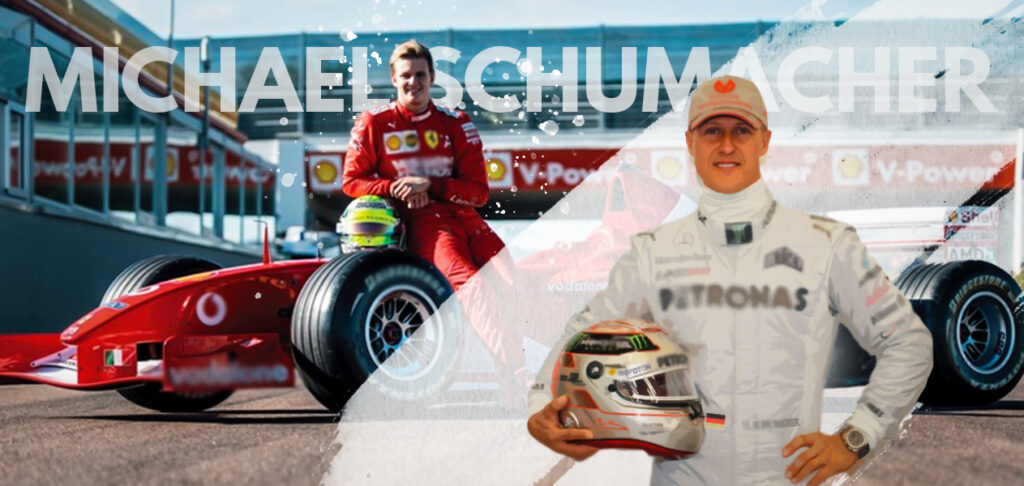 Quite simply put, Michael Schumacher is probably the greatest driver to have ever raced in Formula One. Although with the current Mercedes dominance, Lewis Hamilton will probably break some of Schumacher’s records, but the German remains the greatest not only because he won seven world titles or ninety-one races, or that he could drive a car to its limit to extract everything from it, but because was also a fascinating character out of the car. A competitive, complex and supreme athlete, there will be no one coming close to Schumacher.
Quite simply put, Michael Schumacher is probably the greatest driver to have ever raced in Formula One. Although with the current Mercedes dominance, Lewis Hamilton will probably break some of Schumacher’s records, but the German remains the greatest not only because he won seven world titles or ninety-one races, or that he could drive a car to its limit to extract everything from it, but because was also a fascinating character out of the car. A competitive, complex and supreme athlete, there will be no one coming close to Schumacher.
Schumacher broke onto the scene in the early 1990s, with his rise coinciding with the end of Senna’s career. It was a symbolic passing of the baton, but probably not in the way Michael would’ve wanted. Schumacher started his career in 1991 with Jordan before switching to Benetton the following year. The Benetton move proved to be a successful one for the German as he won consecutive titles with the team in 1994 and 1995. As good as he was on the track, he polarised people off it. His 1994 title showdown with Damon Hill is talked about till date, as both cars crashed out in the final race to hand Schumacher the win. Many believe – even today – that the German did it on purpose, although the FIA have deemed it as a racing incident.
The 1996 season saw Schumacher move to Ferrari, where he would stay until 2007. Schumacher came closest to his first world title with Ferrari in 1999, but an injury in the British Grand Prix saw Mika Häkkinen regain championship lead and win his second consecutive championship with McLaren.
The turn of the century also brought a turn of luck in Maranello. Schumacher paired up with Rubens Barrichello led Ferrari to unprecedented heights. Although Häkkinen came close in 2000, the following few seasons saw utter dominance from Ferrari and Schumacher. The German won 9 races in 2001 and 11 in 2002 to win his third consecutive title with Ferrari and fifth overall. 2003 saw some challenge from Kimi Räikkönen and Juan Pablo Montoya, but no one was dominant enough to stop Schumacher from getting his sixth world title. The next season saw Schumacher back to his very best as he won an incredible 12 of the opening 13 races to secure a world-record seventh driver’s title. The next two seasons saw Renault rise up to the Ferrari challenge, and along with regulation changes, Schumacher handed his crown over to a new champion – Fernando Alonso.
Schumacher retired at the end of the 2006 season. He worked closely with the Ferrari team and almost made a comeback to fill in for the injured Felipe Massa in 2009. Three years off the track had reignited Schumacher’s passion for the sport, and the German made his return to Formula One with Mercedes in 2010. Although his final stint with Mercedes was a tough one, there were glimpses of his excellence. A third-place finish in Valencia 2012 marked the final time Michael Schumacher was on the podium. Schumacher retired for good at the end of the 2012 season, bidding adieu to a 19-year career.
Michael Schumacher’s 91 victories and 7 world titles were untouched until his successor at Mercedes, Lewis Hamilton, broke both those records in 2020. Schumacher had a major skiing accident in 2013 and suffered significant brain injury that had left him bed-ridden and under medical supervision.
5. Lewis Hamilton – 7 World driver’s championships*(McLaren, Mercedes)
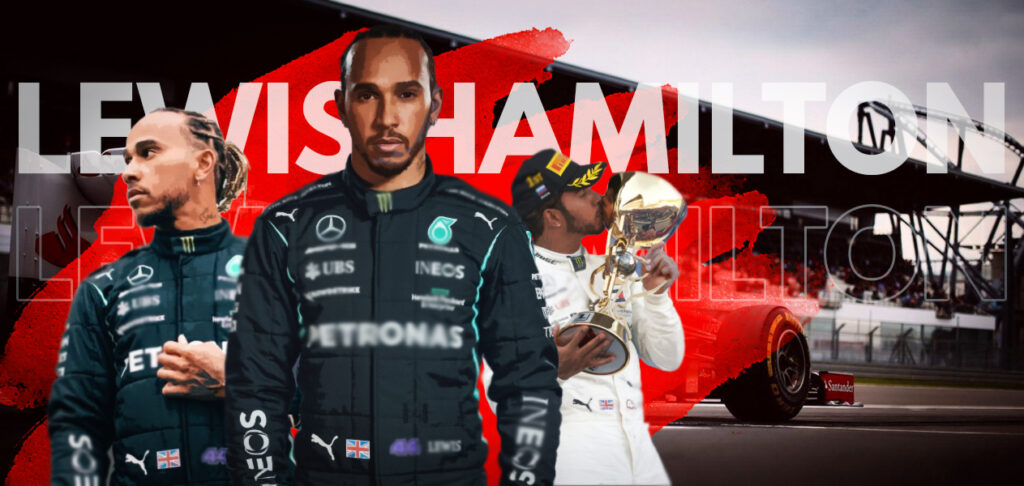 Statistically, Lewis Hamilton is the greatest driver of all time. With 98 victories and seven world titles, Hamilton’s dominance in the turbo hybrid era is unprecedented, unchallenged and unheard of.
Statistically, Lewis Hamilton is the greatest driver of all time. With 98 victories and seven world titles, Hamilton’s dominance in the turbo hybrid era is unprecedented, unchallenged and unheard of.
The Brit made his debut in 2007 with McLaren and was paired up with two-time world champion Fernando Alonso. Straight off the bat, Hamilton showed that he was not someone to be taken lightly and went on to have the greatest rookie season. Throughout the season, Hamilton and his teammate came to blows numerous times. The continuous battle amongst the teammates boiled over at the 2007 Hungarian Grand Prix where Alonso held Hamilton up in the final qualifying session, leaving the Brit no time to do his final hot lap. Alonso was penalised and took a five-place grid penalty, but the chinks in the McLaren team were more than visible now. McLaren’s off-track troubles saw them disqualified from the Constructors’ Championship, and Hamilton had a heartbreak in the final race of the season, as a poor race along with technical difficulties saw the 2007 championship slip away by a solitary point.
Hamilton bounced back stronger in 2008, with Alonso having left the team; he took charge as the team leader at McLaren and won his first driver’s title in 2008 in a dramatic manner – right in the final corners of the final race. Throughout the season, Hamilton had been involved in a close contest with Ferrari’s Felipe Massa. In the final race of the season, Massa took the chequered flag with Hamilton lying at P6, which would have taken away the title from him again. But Toyota’s Timo Glock got passed by Sebastian Vettel and Hamilton in the final corners of the race, which put Hamilton up to P5 and won him the championship by one point. Hamilton endured a tough few seasons with McLaren from 2009 to 2012, with reliability issues costing the Brit potential championships. Hamilton replaced the departing Michael Schumacher at Mercedes in 2013 and hasn’t looked back since. With regulation changes in 2014, Mercedes have won every single Constructors’ and Drivers’ Championships, with Hamilton taking 6 of the 7.
Regarded as one of the most complete drivers to have ever raced, Hamilton excels over a wide range of areas. A naturally aggressive driver, Hamilton is known to extract everything from whatever car he drives. He is one of the few drivers in the sport who can drive any car, rather than having to rely on any one car. Known for his wet-weather drives, Hamilton masters the races under rain. He won every race under the rain – from the 2014 Japanese Grand Prix to the 2019 German Grand Prix – which not only showcases his wet-weather driving skills but also his consistency. It was no surprise that Hamilton clinched his world-record equalling seventh title in a wet Turkish Grand Prix in 2020.
Hamilton’s success in the sport is unparalleled, and one can only wonder how much longer he can dominate the scene for. Even though there have been challenges over the years and stronger opponents at times, Hamilton has always come out on top and that is what sets him apart. His passion and excellence for the sports, along with him using his position to raise awareness of relevant social matters, has earned him a knighthood and a corner name at the Silverstone Circuit.
6. Alain Prost – 4 Drivers’ World Championships (McLaren, Renault, Ferrari, Williams)
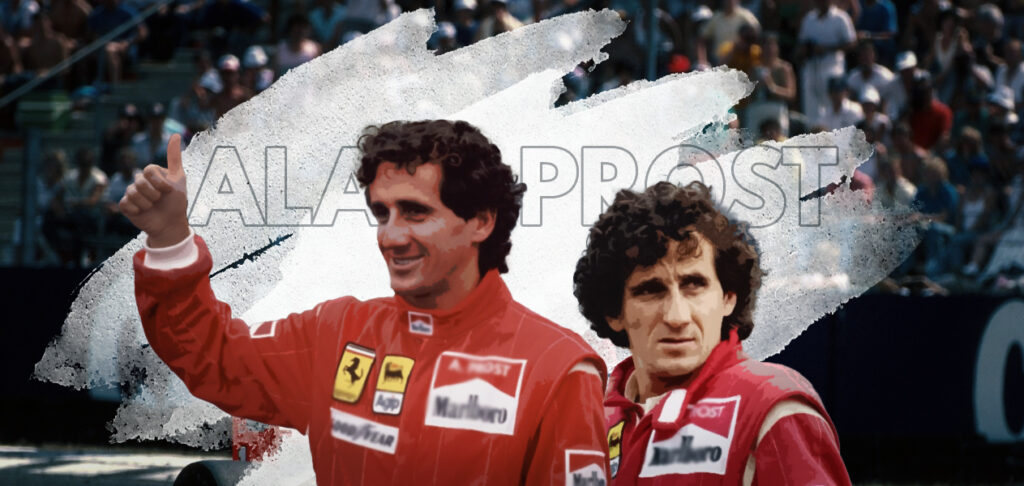 The Professor himself. Known as the thinking fan’s greatest driver, Alain Prost’s intuitive reading of the sport made him one of the best. Dominating the 1980s, the Frenchman was aptly nicknamed ‘The Professor’ for his intelligent and by-the-book approach to racing. If Alain Prost had to finish 5th to take the championship, Alain Prost finished fifth. Even if he had the pace for a podium finish, Prost made sure he did just enough to see himself through.
The Professor himself. Known as the thinking fan’s greatest driver, Alain Prost’s intuitive reading of the sport made him one of the best. Dominating the 1980s, the Frenchman was aptly nicknamed ‘The Professor’ for his intelligent and by-the-book approach to racing. If Alain Prost had to finish 5th to take the championship, Alain Prost finished fifth. Even if he had the pace for a podium finish, Prost made sure he did just enough to see himself through.
Prost joined McLaren in 1980, but reliability issues left the Frenchman heading over to Renault the very next season. The move turned out to be a successful one, as Prost took victory at the French Grand Prix in 1981. The following season saw reliability issues creep up again which affected Prost’s championship hopes, and 1983 saw Prost lose out to Nelson Piquet in the very final race of the season. Prost, known to be vocal about his thoughts, criticised the French team and was subsequently dropped.
Prost then signed up with McLaren, who paired up the Frenchman with Niki Lauda. The season started in perfect manner for Prost as he won in Brazil; a further six wins in his debut season with McLaren saw the Frenchman come agonisingly close to winning his first championship. Lauda beat Prost by half a point, which allowed the Austrian to secure the 1984 Drivers’ Championship. The following two seasons saw Prost taken consecutive titles and cement his place as one of the greats.
The 1988 season saw the then McLaren boss Ron Dennis sign Ayrton Senna for the British team and as the say – the rest was history. Sparks set off right from the start; Prost dominated his new teammate for the first couple of races, but the Brazilian hit back with a flurry of victories. Senna eventually pipped Prost for victory in ’88, but constant tensions and incidents between the two were high by this point, especially the following season when Prost and Senna collided at the championship defining race, which took Prost out of the race and had Senna disqualified. The following season saw Prost shift to Ferrari; with tensions at an all time high at McLaren, it seemed like it was the best move for both drivers. Senna crashed into Prost in Suzuka once again, just like he did twelve months ago, but this time Senna emerged victorious, taking the driver’s title for himself. Prost began to feel the heat of not only not being able to win but having to see Senna win. His relationship with Ferrari, in turn, turned sour. Publicly criticising the Maranello-based outfit didn’t go down well with the Scuderia, who fired Prost – an end similar to his exit from Renault. But Prost always had a back-up plan in hand. He signed for Williams in 1993 and dominated the field, taking his fourth and final driver’s title.
Prost decided not to defend his title and retired at the end of the 1993 season. He returned a few years later as boss of a team named after him, but poor performances saw the team shut down for good.
Prost currently serves as an ambassador and team advisor for the French team Alpine (previously known as Renault)
7. Fernando Alonso – 2 Drivers’ World Championships* (Minardi, Renault/Alpine, McLaren, Ferrari)
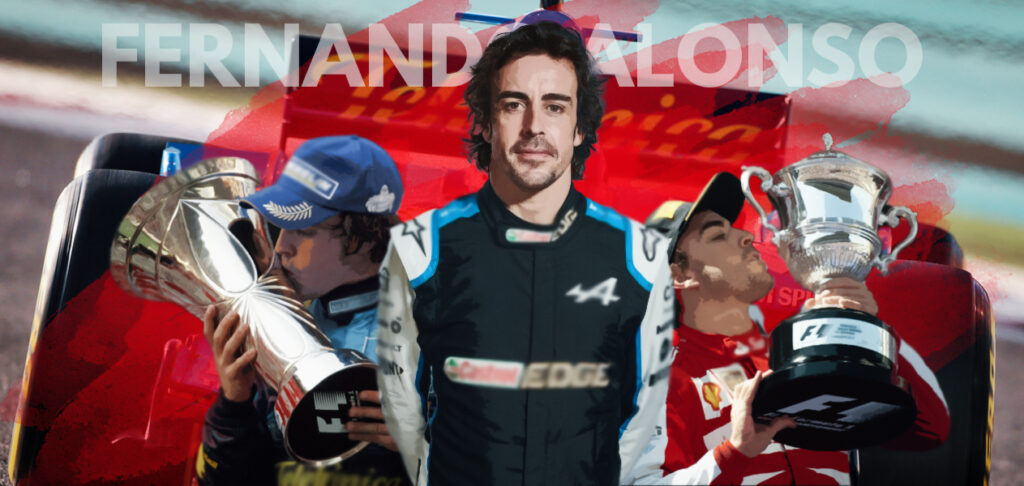 The boy who dethroned the King. Fernando Alonso shot onto the scene in the early 2000s when he ended a dominant Ferrari’s run in 2005, winning two consecutive world championships with the Renault team. Alonso is inexplicably fast wherever he is, whatever the machinery is, and has a knack for driving it beyond its capabilities.
The boy who dethroned the King. Fernando Alonso shot onto the scene in the early 2000s when he ended a dominant Ferrari’s run in 2005, winning two consecutive world championships with the Renault team. Alonso is inexplicably fast wherever he is, whatever the machinery is, and has a knack for driving it beyond its capabilities.
Alonso made his debut with Minardi in 2001, but Minardi barely had any speed for the young Spaniard to showcase his lightning speed. Alonso sat out the 2002 season in hopes of finding a good seat for the following season, serving as a test driver for Renault for the season. The young Spaniard returned to Formula One in 2003 with Renault and was on the pace right away. He took pole in second race in Malaysia, becoming the youngest pole sitter at the time.
In Hungary, perhaps, Alonso demonstrated what truly was to come – a fascinating drive. Alonso not only won the Hungarian Grand Prix but also lapped that season’s champion Michael Schumacher en route.
The following season saw Schumacher and Ferrari utterly dominate the entire season with little luck going Alonso’s way. The next season saw Ferrari on the back foot and Renault making the most of it. Alonso did to Ferrari what Ferrari had done to all the teams for multiple seasons – utterly dominate. He took seven victories that season, with stunning performances in Suzuka and Melbourne standing out in particular. 2006 saw a resurgent Ferrari take the fight to the young champion. Although Alonso started the season strongly, Schumacher came back even stronger. Alonso took the championship at the very final race of the season when the Ferrari of Schumacher failed him, therefore, making the Spaniard the youngest ever to win back-to-back championships at the time.
Alonso shifted to McLaren in 2007 and came extremely close to taking a third consecutive Drivers’ Championship, but lost out to Ferrari’s Kimi Räikkönen by a solitary point. That season also saw Alonso embroiled in a season-long tussle with his young rookie teammate Lewis Hamilton. Räikkönen eventually took advantage of McLaren’s inter-team disputes and pipped both the McLaren drivers to the championship. But even in Fernando’s arguments, you could see his genius. Case in point, at the Hungarian Grand Prix, Fernando held up Hamilton just long enough for him to miss out on a final flying lap. Fernando, as he waited in the pit box, perfected the exact time he would need to take pole and stop Hamilton from doing so.
Inter-team disputes and public criticism saw McLaren and Alonso ending their contract, which saw Fernando head back to Renault. However, his return to Renault for ’08 and ’09 didn’t see much success. For the following season, Ferrari paid off Kimi Räikkönen to clear the seat for Alonso, who started with a win at Ferrari, taking victory at Bahrain. But reliability issues along with penalties put him on the back foot for the championship, with Ferrari botching up their strategy in the very final race in Abu Dhabi to see Sebastian Vettel become world champion. During the next few seasons, Ferrari just couldn’t provide Alonso with a championship-winning car, which hampered his hopes of a third title. Alonso again came agonisingly close in 2012 but in all honesty, the fact that the F2012 even competed for the championship was all down to Fernando’s mastery and ability to take a very ordinary and, at times, third best car on grid to the title showdown. Red Bull’s dominance didn’t allow Fernando to take his elusive third title, who was public about his thoughts regarding Ferrari’s shortcomings in not being able to give him a championship-winning car.
Alonso left Ferrari and returned to McLaren in 2015, seven years after his bitter exit. The return, though, wasn’t anything promising for the two-time world champion. An uncompetitive car was made to look better than what it was purely due to Alonso’s mastery of the craft. Races such as Australia 2018 and Azerbaijan 2018 saw McLaren bag handy points, although they shouldn’t have. After four years of toiling and not seeing success in the distant future, Fernando Alonso retired for the first time at the end of the 2018 season, drawing the curtains over an illustrious, controversial and remarkable 18-year career.
Even when he left, it felt like he wasn’t finished with the sport, and so it was – Alonso re-signed with Alpine (formerly known as Renault) for one final bout. It will be interesting to see what the Spanish superstar can do, but nonetheless, what can be guaranteed is that Alonso will give his everything to take his Alpine car well above where it should be.
Alonso is, undoubtedly, one of the greats of the sport. His teammates have said that his greatest trait is knowing when to go fast and when to slow down to preserve his tyres. Like Senna and Hamilton, Alonso is one of the few drivers that will drive any machinery quick and make it competitive.
8. Sebastian Vettel – 4 World Drivers’ Championships* (BMW, Toro Rosso, Red Bull, Ferrari, Aston Martin)
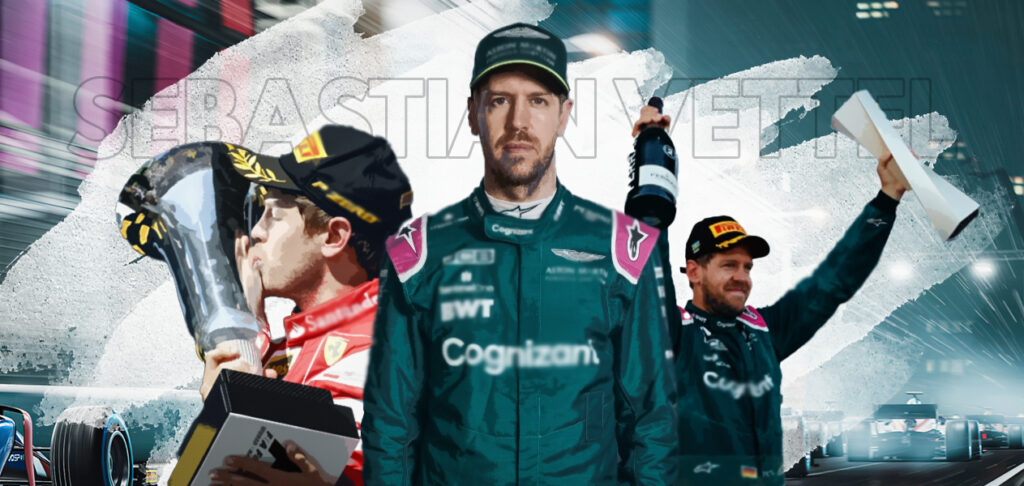 Sebastian Vettel was very much the poster boy for Formula One in the early 2010s with a dominance that was similar to fellow compatriot Michael Schumacher’s with Ferrari in the early 2000s.
Sebastian Vettel was very much the poster boy for Formula One in the early 2010s with a dominance that was similar to fellow compatriot Michael Schumacher’s with Ferrari in the early 2000s.
Vettel started his career as a test driver with BMW in 2006. The then young German filled in for the injured Robert Kubica in the 2007 Canadian Grand Prix and finished an impressive 8th. Vettel signed up with Toro Rosso and replaced Scott Speed for the Italian outfit. He was impressive throughout the season, getting decent point finishes, but it was the young German’s shock win at Monza that made the world take notice of this 21-year-old. Winning the 2008 Italian Grand Prix from pole immediately caught the attention of Red Bull, and they signed him on as the departing David Coulthard’s replacement in 2009.
Vettel endured a tough start, but a stunning drive at Shanghai gave not only Sebastian his first win as a Red Bull driver but also gave Red Bull their first ever win. Vettel would go on to end the season as runner-up behind the Brawn of Jenson Button. Retirements and collisions hampered Vettel’s chances of taking his very first drivers’ championship.
Red Bull carried their form into the following season, with Vettel starting ten of the nineteen races of the season from pole position. Although a charge from Alonso made him a potential candidate, Vettel held his own to take his fifth win in the final race in Abu Dhabi and become the youngest-ever world champion. Vettel took 11 victories out of 19 in 2011 and comfortably dominated the entire field with a Red Bull that looked unstoppable, in turn becoming the youngest double world champion.
2012 saw Vettel face multiple challenges from the likes of Alonso, Hamilton, Button and his teammate Mark Webber. Although the season was wide open during the first half of the season, post the summer break Vettel found form, and with technical difficulties for the McLaren drivers and Ferrari not having the pace to match him, Vettel took his third consecutive world championship in a thrilling showdown in Brazil that saw him charge through the field after first lap contact to pip Fernando Alonso for the title.
The following season was Vettel once again showcasing his dominance in an unmatchable Red Bull that saw him take a whopping 13 victories out of the 19 races. Vettel won all of the final 9 races of the season – a record that hasn’t been broken till date. The German’s dominance saw him secure his fourth world title with three races to go, in turn becoming the youngest ever to win four world titles at the age of 26.
A change in regulations in 2014 saw the dominance of Red Bull and Vettel come to an end, with Vettel enduring a tough season that saw his new teammate Daniel Ricciardo outscore him. The end of 2014 saw Vettel leave Red Bull and replace Fernando Alonso at Ferrari. Even though Ferrari mounted a decent challenge in 2015, with Vettel taking wins in Malaysia, Singapore and Hungary, the previous year’s regulation changes saw the rise of Mercedes, who were slowly beginning to become untouchable. The following season was a winless season for Vettel and one that had missed opportunities in races such as the Australian Grand Prix and Canadian Grand Prix.
2017 saw Vettel mount his first proper challenge towards Mercedes, with Hamilton and Vettel exchanging wins throughout the opening half of the season. The season, however, went south for Vettel in the Asian rounds as DNFs in Singapore and Japan left Hamilton far ahead of Ferrari. The following season seemed to be finally the one where Vettel would get his elusive fifth title, with the German starting the season strongly and comfortably seeing off the Mercedes, but crashing out in his home race at Hockenheim and not competing for the victory in Monza, Suzuka and Austin saw Hamilton pip Vettel yet again for the fifth title.
2019 saw Vettel have a new teammate in Charles Leclerc, who replaced Kimi Räikkönen. Leclerc was supposed to play second fiddle to Vettel, but the Monegasque straight-away showed his pace and took 7 poles and 2 victories compared to Vettel’s 1 victory and 2 poles. Vettel endured an even worse 2020, where he had to drive an uncompetitive Ferrari, and finished 6th in the Constructors’ Championship. Vettel’s misery saw him collect only 33 points – his lowest ever in a full season – and finish on the podium just once. At the start of the 2020 season, Ferrari had announced that they wouldn’t extend Vettel’s contract, bringing to end a rollercoaster of six years for the German at Maranello. Vettel joined Aston Martin Cognizant for 2021 and will hope to have a better car to fight for podiums and wins that could see him get back to the front of the field.
Vettel is known for his hard work and dedication towards the team, even outside the car. The German is one of the few drivers who spend a lot of time at the factory working with their engineers trying to understand the car better.
9. Kimi Räikkönen – 1 Drivers’ World Championship* (Sauber/Alfa Romeo, McLaren, Ferrari, Lotus)
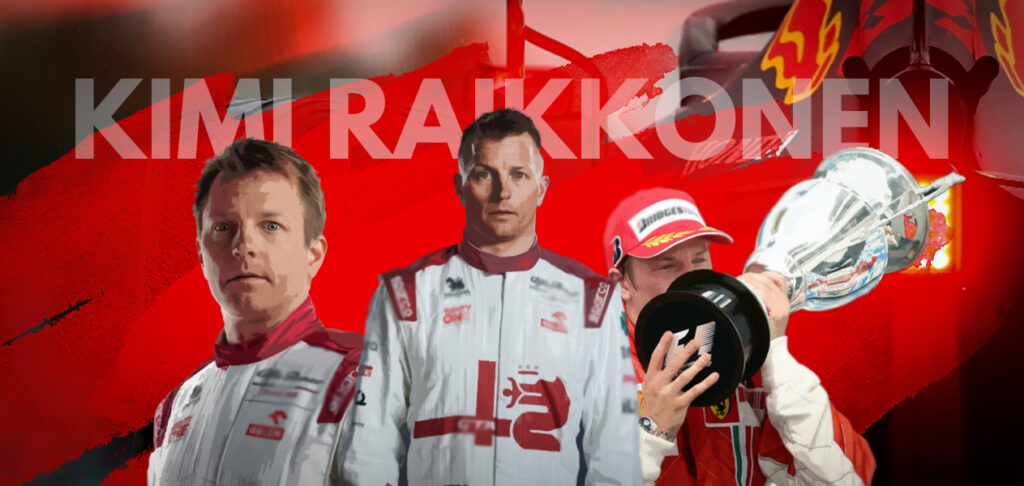 When Kimi Räikkönen made his debut with Sauber in 2003, a lot of eyebrows were raised and questions were asked. After all, how could a 21-year-old with only 23 race starts and no super licence have gotten one of motorsports’ most coveted seats? Although many a question was put forward, Räikkönen’s performance on his debut – finishing a smashing P6 – silenced all the critics. Although reliability issues would lead to Räikkönen failing to finish his next three races, the young Finn’s maturity and speed were enough to show the FIA and the world what he could do.
When Kimi Räikkönen made his debut with Sauber in 2003, a lot of eyebrows were raised and questions were asked. After all, how could a 21-year-old with only 23 race starts and no super licence have gotten one of motorsports’ most coveted seats? Although many a question was put forward, Räikkönen’s performance on his debut – finishing a smashing P6 – silenced all the critics. Although reliability issues would lead to Räikkönen failing to finish his next three races, the young Finn’s maturity and speed were enough to show the FIA and the world what he could do.
Räikkönen replaced his compatriot, Mika Häkkinen, at McLaren, with reports stating that Räikkönen had turned down Ferrari for McLaren, since the Finn didn’t want to be a number two at Ferrari. Räikkönen had a troubled start with McLaren; although he took a podium on debut, he retired in eight of the seventeen starts that season and was nowhere near the dominant Ferrari.
The following season saw an improvement of sorts for the Finn, with him taking his first victory in Malaysia. Although Räikkönen had a competitive car to challenge for the championship, reliability issues once again let him down. A win was taken away at Germany due to engine failure. Although Schumacher beat Räikkönen by two points to take the championship, Kimi had strong performances throughout the season that made him a worthy title contender despite having taken a solitary victory in comparison to Schumacher’s six.
Räikkönen unfortunately could not mount a championship challenge the following season as the MP4/18 was a total mess with zero reliability, with the Finn having to retire eight times in the season. Räikkönen was joined by Juan Pablo Montoya for the 2005 season, and even though the car wasn’t totally reliable, Kimi luckily had only two retirements. Although he fought hard and took the fight to Alonso, Räikkönen’s main highlight of the season – one that has gone down in Formula One’s history books – is his remarkable and stirring win at Suzuka that saw him come from 17th on the grid to overtake the leader in the final lap to take an unlikely victory.
The next season saw McLaren finally overcoming their reliability woes, but it came at the cost of performance, with the car not being close to the front of the grid. Räikkönen ended his tenure at McLaren and replaced Michael Schumacher at Ferrari in 2007.
Räikkönen made the perfect start for his new team, taking victory at the season opener, but tough competition from (ironically) the McLarens of Fernando Alonso and rookie Lewis Hamilton saw him play catch-up to the championship leaders Alonso and Hamilton. The Finn, though, stayed in contention throughout the season, and really became a threat when he won the Chinese Grand Prix, setting up a thrilling finale. Hamilton, who looked to take the championship in his rookie year, suffered from gear-box problems, and Alonso also couldn’t fight for the victory, which meant Räikkönen became a world champion with Ferrari in his very first season.
Strategy mishaps and the occasional driver mistakes left Räikkönen a distant third on his defence of the world title in 2008, and an uncompetitive F60 in 2009 saw him take Ferrari’s only victory of the season. Despite having a contract till 2010, Räikkönen was paid off by Ferrari to make way for Fernando Alonso, which made the Finn leave the sport as a whole and try out the World Rally Championship and NASCAR for the next two years.
Räikkönen returned to Formula One in 2012 with Lotus and a string of solid performances – including a memorable win at Abu Dhabi – saw the Finn finish 3rd in the Drivers’ Championship after two years out of the sport. The following season saw Kimi start off with a stunning victory at Australia, but a dominant Red Bull with an improving Mercedes saw Räikkönen finish fifth in the championship with 7 podium finishes.
Räikkönen returned to Maranello in 2014 to partner Fernando Alonso, but an uncompetitive F14 T saw Räikkönen finish outside the top ten in the Drivers’ Championship. He played second fiddle to Alonso’s successor, Sebastian Vettel, who joined the team in 2015 and even though Vettel took all of Ferrari’s victories from 2015-2017, Räikkönen consistently performed well, getting multiple podium finishes in every season.
Räikkönen could have taken his first victory at Monaco in 2017, but a strategy call from his team saw his teammate undercut the Finn and pip him for victory. Although it was Vettel who took all of Ferrari’s victories, Räikkönen ably supported Vettel and held off the Mercedes cars whenever necessary. Räikkönen finally ended his five-year wait for a trophy when he won the 2018 United States Grand Prix. He could’ve scored a further few victories in the 2018 season, but misfortune and team strategies meant Räikkönen had to be content with podium finishes.
It was announced in mid-2018 that Räikkönen would be replacing Charles Leclerc at Alfa Romeo for 2019, with the Monegasque taking the Finn’s place at Ferrari. Räikkönen returned to a pressure-free environment at Alfa Romeo and did what he wanted to do – just race. Now in his 21st season in the sport, Räikkönen still comfortably has the better of his teammate at Alfa Romeo and uses all his experience to score the occasional points.
Even though Kimi Räikkönen might not have as many victories or Drivers’ Championships as the others on this list, what makes him a great is his longevity in the sport. Heading into this third different decade that he is racing in, Räikkönen seems to be simply enjoying his racing. Known for his dislike of the media and an affinity for monosyllabic answers, Räikkönen is nicknamed ‘The Iceman’ for his ice-cool persona and has gained a cult persona over the years.
10. Alberto Ascari (Ferrari, Maserati, Lancia)
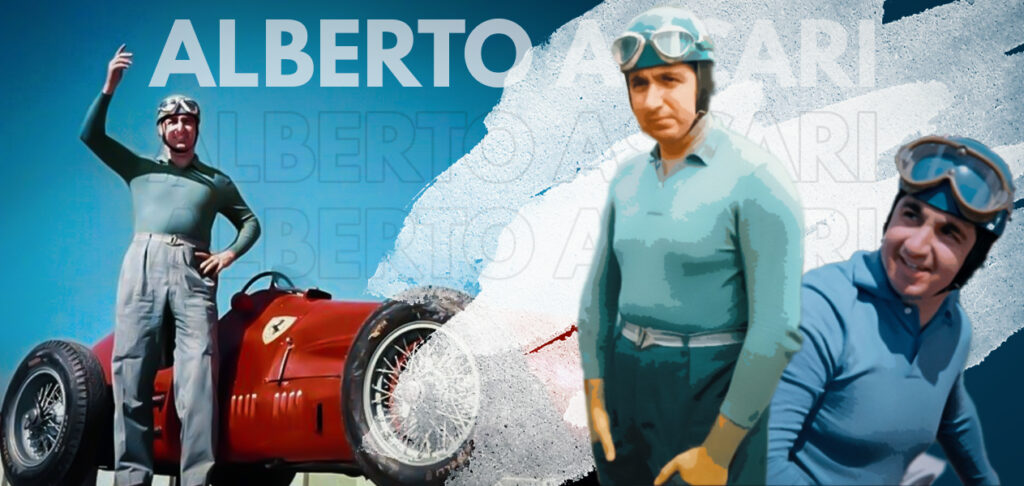 The Italian racing legend, who is the only person along with Schumacher to win back-to-back titles with the Scuderia, Ascari was one of the original stars of Formula One. He was one of the only drivers to have challenged the great Fangio during the Golden Era.
The Italian racing legend, who is the only person along with Schumacher to win back-to-back titles with the Scuderia, Ascari was one of the original stars of Formula One. He was one of the only drivers to have challenged the great Fangio during the Golden Era.
Ascari was described by Ferrari team boss Enzo Ferrari as ‘virtually impossible to overtake when leading’. Alberto was signed by Enzo Ferrari, who was a close friend of his father, Antonio. Alberto participated in the very first Formula One World Championship in 1950 at Monte Carlo. Due to engine issues, he could only manage a best finish of second at Ferrari’s first ever Italian Grand Prix.
The following season saw Ascari turn up as a genuine threat to the charging Alfa Romeo, but reliability issues held him back. He ended the season as runner-up, having taken two victories at Nürburgring and Monza. Strategy errors, which led to poor tyre choice, saw Fangio clinch the title and leave Ascari out of the podium places.
The following season saw engine regulation changes that worked in the Italian team’s favour. Ascari won six of the season’s eight races and sealed his first championship. He started the following season right where he left off, with wins in the opening three races of the 1953 Formula One season. A further two wins later in the year saw the Italian become Formula One’s first two-time champion. Ascari left Ferrari the next season over negotiation disputes and joined Lancia.
In a bizarre turn of events, Lancia didn’t have a car ready for the final race and let Ascari race for Maserati. Reliability issues with Lancia meant Ascari retired in every single race of that season. The following season started off promisingly, with Ascari taking victories in Turin and Naples. Post the Monaco Grand Prix which turned out to be Ascari’s last appearance, a terrible accident whilst testing the Ferrari car cut short a promising career. Because of not many safety measures present at the time of his accident in Monza, Ascari died on the spot.
Although short, Alberto Ascari’s career is one for the record books. With thirteen victories out of thirty-three starts, the Italian remains one of the greats of the sport. He remains only the second Italian world champion for Ferrari.
*Indicates drivers who are currently active.
